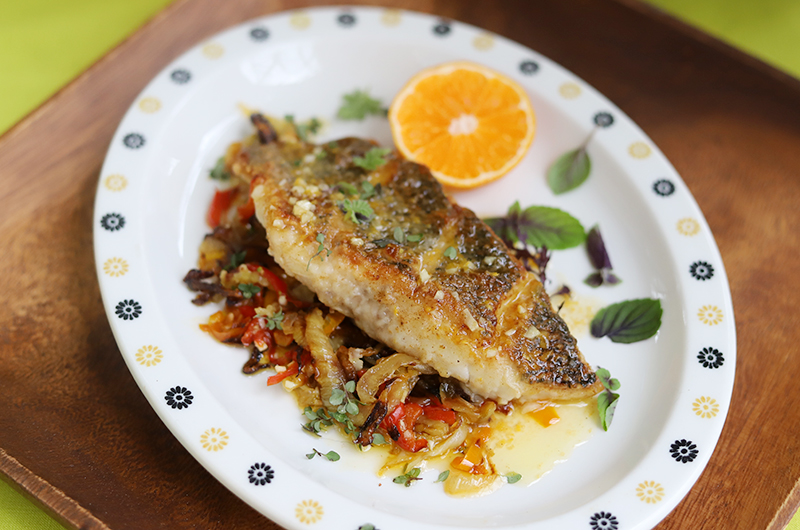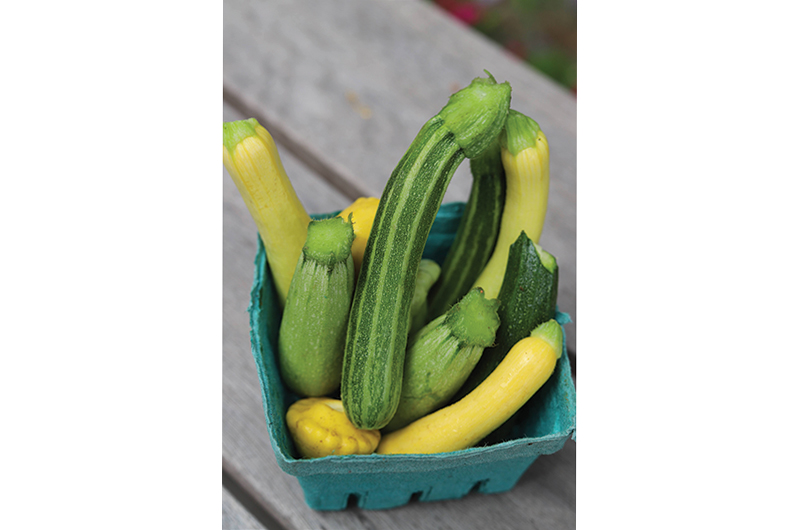Black sea bass is an incredibly tasty fish – well worth the tiny effort to learn to cook it. Your fish monger will almost certainly give you the fillets with the skin on, which holds the flesh together. Don’t remove it! This technique for sear-roasting the fish will give you crisped, browned, tasty skin. The first trick is to slash the skin of each fillet in two or three places. This will keep the fillet from curling up while it is cooking.
Secondly, you’ll want to use an easy restaurant technique to cook the fish. It’s called sear-roasting. Sear the fillets skin-side down first in a hot pan. Then, instead of finishing the fillets on the stovetop, you’ll flip them and transfer them to a hot oven to finish cooking for just a few minutes. Finishing in the oven is a bit gentler and allows you to do two things: you can arrange the seared fillets over a pan of already-roasted vegetables (in this case, thinly sliced fennel, onions, and bell peppers) and you can use the empty skillet to make a little pan sauce in the meantime.
Feel free to vary the flavors here by changing up the vegetables, the citrus juices, or the herbs. You can also add chopped olives or chopped hardy herbs to the roasted vegetables, depending on the season. And by the way, this approach works with other firm white fish fillets, such as halibut.
Serves 2 to 3
- 3 tablespoons unsalted butter
- 4 tablespoons olive oil
- 4 cups thinly sliced fennel bulb, bell peppers, and onions (in any combination)
- Kosher salt
- 1 pound black sea bass fillets (about 3 or 4 small)
- Flour for dusting
- 1 tablespoon chopped fresh garlic
- 3 tablespoons freshly squeezed citrus juice (a combination of orange and lemon is nice)
- 1 teaspoon freshly grated citrus zest
- Fresh herb leaves (mint, basil, cilantro, thyme, or chives) for garnish
1. Heat the oven to 400 degrees. Cut 2 tablespoons of the butter into dice and return them to the refrigerator to stay cold.
2. Combine 3 tablespoons of the olive oil, sliced vegetables, and a ½ teaspoon of salt in a 9-by-13-inch glass or ceramic baking dish or roasting pan. When the oven has preheated, put the pan in and roast the vegetables, stirring every 10 minutes or so (especially along the sides), until the vegetables are shrunken and nicely caramelized, about 30 minutes. Remove the pan from the oven and stir 2 teaspoons of the garlic into the vegetables. Spread the vegetables back out in one snug layer
in the pan – just big enough to arrange the fillets over.
3. Meanwhile, using a sharp knife, score the skin of each fillet in two or three places, cutting through the skin (all the way from side to side), but not down into the flesh (at least as little as possible!). Season each fillet generously with salt and dredge in flour, shaking off excess, so that both sides are lightly coated.
4. When the vegetables are almost done roasting, heat the remaining tablespoon of butter and oil in a large (12-inch) nonstick skillet over medium heat. When the butter has melted, turn the heat up a bit (to a medium-high) and add the fillets, skin-side down, to the skillet. Cook without disturbing for 4 minutes. Check with a thin spatula to see if the skin is nicely browned. If not, continue cooking 1 to 2 minutes. Remove the skillet from the heat.
5. Flip the fillets and arrange them, skin-side up, in the roasting pan over the vegetables. Return the roasting pan to the oven and cook for 4 to 6 more minutes to cook the flesh through.
6. Add the remaining teaspoon of garlic, juices, and zest to the skillet and return it to medium-low heat. Let the juices heat through and begin to reduce (about 30 seconds if the pan is still hot). Remove the pan from the heat and stir in the cold pieces of butter one by one. You want them to melt just to a creamy consistency.
7. To serve, use a metal spatula to transfer each fillet, along with some of the pan-roasted vegetables underneath it, to a warm serving plate. Spoon some of the butter sauce overall. Serve right away, garnished with fresh herb leaves.








